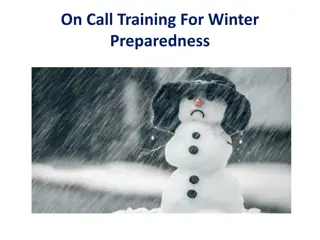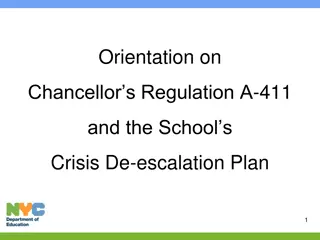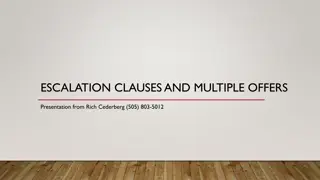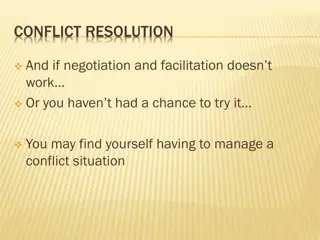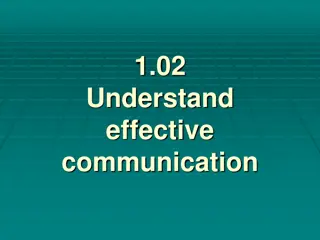Techniques of Verbal De-escalation in Healthcare Settings
This presentation provides valuable techniques for recognizing and diffusing potentially volatile situations in healthcare environments to ensure the safety of staff members. It covers topics such as defusing anger, understanding displaced anger, dealing with hostile patients, and effective communication strategies. By empathizing, listening actively, and addressing concerns, healthcare professionals can de-escalate conflicts and promote a safer workplace.
Download Presentation

Please find below an Image/Link to download the presentation.
The content on the website is provided AS IS for your information and personal use only. It may not be sold, licensed, or shared on other websites without obtaining consent from the author. Download presentation by click this link. If you encounter any issues during the download, it is possible that the publisher has removed the file from their server.
E N D
Presentation Transcript
Universal Behavioral Precautions: Techniques of Verbal De-escalation Anne Pugh, MSW, LCSW Patient Services Manager Health Services Advisory Group (HSAG) April 20, 2018 Originally Presented by: Maureen Rasmussen, MSW Nephrology Social Worker American Renal Associates, St. Petersburg, FL September 19, 2017
Purpose This presentation will: Help you to recognize situations that impact potential verbal and physical abuse by a patient or visitor toward staff. Provide tools to help you de-escalate a potentially volatile situation. Your safety and welfare are very important to us! *https://www.abss.k12.nc.us/cms/lib/NC01001905/Centricity/Domain/2536/3.02%20%20Activity%20W orkplace%20Violence%20PP%20.pdf 2
Defusing Anger, Frustration, and Conflict The Challenge: How to effectively defuse the anger of a patient, family member or visitor in a calm and professional manner. 3
Displaced Anger What is anger? Anger is a response to feeling threatened, afraid, frustrated, or hurt. Why anger? Anger could be a response to a perceived lack of control. Patients may be upset that they are in the patient role. Where anger? People frequently displace their anger on a safe target. Patients may choose to displace their anger on those who are providing their care. 4
When Patients, Families or Visitors are Hostile to Staff They are probably communicating their feelings of: Vulnerability Frustration Emotional overload Fear Helplessness Powerlessness 5
Take the Time to Communicate Identify yourself and your role. Anticipate patient and/or family questions. Draw on your experience. People want to know what to expect. Explain pertinent processes and procedures. Use basic terms/no jargon. Acknowledge the patient s emotional pain, feelings of helplessness, and fears. Empathize! 6
Listening as an Action Hear your patient: Listen to his or her frustration. Empathize with his or her plight. Understand his or her perception. What do they want that they are not getting? Address his or her concerns. Offer a solution or an alternative. 7
Case Scenarios and Suggestions for Defusing a Situation 8
Case Scenario #1 Mr. Johnson arrives at the facility, and a newly-hired tech who he has never met before comes over to assist him. She introduces herself and lets Mr. Johnson know that she will be taking care of him today. Mr. Johnson begins rolling his eyes and says, I don t care who you are. I want my favorite tech, Dottie, to take care of me. The new tech informs Mr. Johnson that Dottie no longer works at the facility, and he becomes more agitated, shaking his head and sighing. When the new tech attempts to cannulate him and misses, Mr. Johnson starts yelling at her, Are you stupid? Dottie would have never missed! He tells the tech he is angry about having to work with someone he has never met, and says he is shocked and upset that his favorite tech is no longer employed by the clinic. The tech says she is sorry, but he begins to curse loudly at her, which disrupts the patients around him. Mr. Johnson also refuses to let the new tech try to cannulate him again. 9
How should this situation be handled? A. The tech summons the charge nurse who tells Mr. Johnson that he needs to calm down and go home because he won t allow the tech to cannulate him and therefore will not receive his dialysis treatment today. She advises Mr. Johnson to follow the facility rules and work on improving his attitude so that he won t have to be put on a behavior contract when he returns. The tech notifies the charge nurse who asks the social worker to talk with Mr. Johnson. The SW actively listens to the his concerns, empathizes with his feelings about the departure of his favorite tech and normalizes his feelings of fear about a new tech cannulating his access. She asks Mr. Johnson to give the new tech a chance and reminds him that Dottie was also new at one time. The SW also apologizes for the way that Mr. Johnson heard about Dottie s departure and agrees to inform the clinic manager of Mr. Johnson s suggestion that patients be informed of personnel changes in a better way. The clinic manager and social worker are told about the incident. They trigger the patient as Unstable and place Mr. Johnson on a behavior contract. None of the above B. C. D. 10
Tips for Defusing a Potentially Volatile Situation Be proactive, not reactive! Notice when a situation begins to escalate by the signs, including: Louder voice. Fidgeting, verbal sounds. Build-up of energy. Stay in control by actively defusing the patient, family, or visitor before a situation gets disruptive. 11
Recognize the Signs of Escalation If a situation continues to escalate: It can become physical. Staff need to defuse the situation by: Reducing stimulation by moving patient to a more quiet location. Communicating information about delays and/or changes. Providing the patient/family choices whenever possible. Note: As emotions increase, auditory processing abilities decrease. 12
Defusing DOs and DONTs DOs DON Ts Calmly but firmly outline the limits of the setting. Allow a frustrated patient time to vent. Give an upset patient, family or visitor plenty of personal space. Avoid arguing or defending previous actions. Avoid using threatening body language. Ignore personal verbal attacks. 13
Focus on the Patient, Not the Rules A patient s perception of whether his or her needs are being recognized and met is what is important. Patients, families, and visitors do not care about the rules of the Centers for Medicare & Medicaid Services (CMS), the state, or any other regulatory bodies. Phrase issues based on their purpose, not because of a rule or policy. 14
Case Scenario #2 Mr. Jones wife died unexpectedly three months ago. He is a long-time patient of the facility and has always been easy-going, friendly, and appreciative. However, Mr. Jones arrives for his treatment today looking sullen and tells the tech he needs to speak with the social worker (SW) right away. He tells the SW that he has to change shifts because the friend who has been driving him to and from dialysis since his wife died is moving away next week, and his daughter can only drive him to and from a first shift chair time because of her work schedule. The SW informs Mr. Jones that there are no first shift spots currently available and agrees to put him on the waiting list. Before she has a chance to discuss transportation alternatives with Mr. Jones, he says in a loud voice, I can t believe you re telling me no! I never ask you people for anything! This is ridiculous! The patients in the area turn to look at Mr. Jones because they are so surprised to hear him yelling. Mr. Jones notices the patients staring; his eyes fill with tears and he says, Just forget it I don t need your help. Leave me alone. He puts his head back on the chair and closes his eyes, and the tech comes over to cannulate Mr. Jones. How should this situation be handled? 15
How should this situation be handled? A. The social worker respects Mr. Jones request to leave him alone because he seems calm at the moment, and she walks away without saying anything. The SW will try to talk with Mr. Jones later today after his treatment is completed. The SW sits down at Mr. Jones chairside and is quiet for a minute, giving him some time to regain his composure. Then she says, I can see that you re upset, and I want to help you. Would you like to talk with me in one of the exam rooms where it s quiet? I can tell you about other transportation options to consider using until you clear the waiting list. The SW puts her hand on Mr. Jones arm, leans towards him and says, Losing your wife must have been so difficult, and I know you re still grieving. It s alright that you got upset. Don t worry. None of the above B. C. D. 16
Tips for Dealing with Agitated Patients, Family Members, or Visitors If there is a family member, caregiver, or friend available, consider asking that individual to join the patient on the treatment floor to provide a calming influence. Limit stimulation and traffic in the treatment area. Keep communication as direct as possible by using plain language. Call for help if necessary. 17
When All Else Fails Management Intervention If all of your attempts to defuse a situation are unsuccessful, someone who is perceived as the person with control and power (e.g., the clinic manager) may need to intervene with patients and family members to define unacceptable and inappropriate behaviors. 18
If a Patient Loses Control Remain professional and in control. Remember, it is not personal. Use a calm voice and simple statements. The patient cannot process as well as normal. Help the patient regain composure. Reduce outside stimulation. Ensure a safe environment for other patients and staff. Respect personal space. Use phrases like, I want to help you, but I need you to Ask for assistance from colleagues. 19
There is No Shame in Asking for Help Sometimes getting assistance from someone who is neutral or has a different approach, like the social worker or clinic manager, can change the dynamics of a situation and help to de-escalate the patient. Do not hesitate to call 911 if necessary. 20
Case Scenario #3 Ms. Smith, whose county-subsidized transportation gets her to the facility 30 minutes early for most treatments, arrives 45 minutes early today, so she sits down in the waiting room. Ms. Smith sees several patients who arrived after she did being called in for their treatments and starts cursing about being ignored. Although her name was not called, Ms. Smith walks through the door right behind another patient and starts yelling at the tech who is assisting the patient ahead of her, demanding that the tech put her on the machine immediately. The tech explains that the patients who were called in ahead of her had earlier appointments; but Ms. Smith is having none of this. She yells and curses at the charge nurse who comes over to check on the situation and asks Ms. Smith to go back to the waiting room until she is called for her appointment. Although it is 15 minutes prior to Ms. Smith s chair time, she loudly tells the charge nurse, I m not going anywhere until you put me on that f#@%ing machine! Ms. Smith s yelling and cursing is beginning to disturb patients in the vicinity. 21
How should this situation be handled? A. The charge nurse tells Ms. Smith that yelling and cursing are against facility rules, and she will have to calm down right away because she is disturbing the other patients. She also tells Ms. Smith to go back into the waiting room and wait for her name to be called when it is her turn. The charge nurse directs the tech in Ms. Smith s pod to put Ms. Smith on the machine right away and let the patient she was about to cannulate wait until Ms. Smith is on her machine. She then tells Ms. Smith, Ok fine, we are putting you on early. The charge nurse asks the clinic manager, who has known Ms. Smith for five years, to talk with her. The clinic manager informs Ms. Smith that her chair is not yet ready and asks Ms. Smith to accompany her into the clinic manager s office so they can talk about her concerns. She says, I want to help you, but I need you to stop yelling and cursing. The clinic manager also asks the social worker to join the conversation. None of the above B. C. D. 22
Re-establish Therapeutic Rapport After an Incident Patients fear that after losing control they will be rejected. Reassure the patient, family, or visitor of your desire to help, as long as they can respect the safety guidelines of the facility. Discuss the need for the staff and patient to address frustrations before they get out of hand. 23
Reporting Protocol Whenever a patient, family member, or visitor expresses verbal or physical threats: Report the incident to the clinic manager. Document the occurrence on an incident report. Contact risk management and/or the ESRD Network for consultation. 24
Why Use the Universal Behavioral Precautions? Your safety is of the utmost importance to us. There is the potential for any patient or visitor to become verbally or, in rare cases, even physically abusive under extreme duress. These tips are designed to help you recognize escalating behavior and take appropriate steps to defuse a situation using de-escalation techniques. *https://www.abss.k12.nc.us/cms/lib/NC01001905/Centricity/Domain/2536/3.02%20%20Activity%20W orkplace%20Violence%20PP%20.pdf 25
Additional Resources and Technical Assistance If you need help, contact the Network Patient Services Staff and/or visit www.hsag.com/ESRD-IVD. Network 7 813.383.1530 x3368 Network 13 800.472.8664 405.942.6000 Network 15 303.831.8818, Option 3 Network 17 415.897.2400, Option 2 or 5 26
Thank you! Anne Pugh, MSW, LCSW Patient Services Manager HSAG 650.389.1082 apugh@nw17.esrd.net This material was prepared by ESRD Network 17, under contract with the Centers for Medicare & Medicaid Services (CMS), an agency of the U.S. Department of Health and Human Services. The contents presented do not necessarily reflect CMS policy nor imply endorsement by the U.S. Government. CA-ESRD-17A135-03282018-01 27












